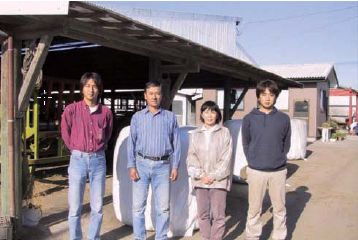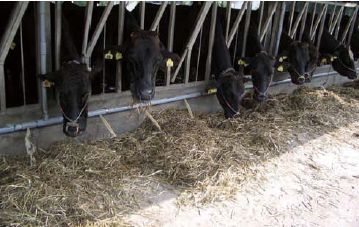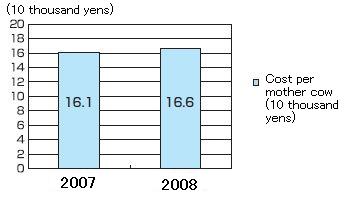| |
 |
|
Low Cost Feeder Stock Breeding by Utilization of Unused Resources
|
| |
|
Kazuo Fujioka: feeding 170 cows for breeding
|
|
Osaki T., So-o County, Kagoshima Pref
|
| |
Keisuke Takahashi
|
| (Livestock Extension Section, Kagoshima Prefecture So-o |
|
Irrigation Agriculture Promotion Center,)
|
|
|
|
|
|
| 1. |
State of Farming |
|
|
Mr. Kazuo Fujioka, after graduating from local agricultural high school, began to engage in agriculture in 1966, succeeding his father as a farm owner in 1976. At that time, he changed the activities from the mixed farming based mainly on racehorse rearing that his father had been managing to the farming centering on the raising of breeding cows.
With his fundamental belief that he should not invest more than necessary for calf production and should reduce cost as possible as he could, he has managed to accumulate his own capital while using the policy fund, and constructed cow sheds in harmony with a long range program for the buildup of herd, so that he has been able to enlarge his farming scale step by step without causing any strain on overall operation.
When he enlarged his herd to 40 cows in 1989, he turned his business to full time breeding farming and constructed more cow sheds by himself, and then began calf production by 7 breeding cows.
From then until now, he has been trying to enlarge the scale steadily according to the reasonable plan formulated under the motto of labor saving and cost reduction.
At present, herd size, labor force, field utilized and available facilities and machines of his farm are as follows; |
|
|
(1) |
Herd size
Beef cows for breeding 170
Fattening cattle 20 |
|
|
(2) |
Labor force
Mr. Fujioka and his wife, his eldest son, his second son |
|
|
(3) |
Land owned and land use
Cultivated land area 20 ha (his own land 7.8 ha)
Summer crop Rhodes grass 5 ha
Winter cropItalian ryegrass 20 ha |
|
|
(4) |
Main facilities and machines
Cow sheds 12 (2,139m2)
Compost barn 1 (320m2)
Tractors 5
Dump trucks 2 |
|
|
|
Forage processing machines (manure spreader, gyrotedder, 3-bottom plow, roll baler, bale wrapper, roll cutter, etc)
|
| |
|

Fujioka family (cowshed in background) |
| 2. |
Efforts to cope with the steep rise of feed prices |
| |
|
|
| |
(1) |
Details of the farmfs efforts |
| |
|
In the pursuit to enlarge his enterprise, Mr. Fujioka has been aiming for the livestock farming primarily based on feed produced by himself through farm management system which uses a certain scale of land instead of depending on purchased feed. Hence, he has been making efforts to establish the stable and labor saving production system for feed self-sufficiency. Among his efforts as an emergency measure against the roughage shortages in the event of bad climate or as that to meet the additional needs of roughage for enlarging the herd size, he has begun to feed cows with the sho-chu lees (distilled spirit from sweet potato or cereals), which are available throughout the year constantly and need hardly any space for storage. He feeds sho-chu lees to breeding cows with a dosage of 10 liters per day per head based on the research data from Kagoshima Prefecture livestock experiment station, in which precaution is taken to avoid negative impact on the breeding performance.
He is feeding liquid sho-chu lees through a pipeline system devised and installed on his own.
|
| |
|

liquid feeding of sho-chu lees with do-it-yourself pipeline
|
| |
|
Simply by opening a valve, several cows can be fed at one time, contributing also to labor saving. |
| |
|
|
| |
(2) |
Effects |
| |
|
The TDN of 10 liters of sho-chu lees is estimated to be equivalent to 700 g of formula feed for breeding cow. Hence by feeding sho-chu lees throughout the year, he is able to reduce feed cost as well.
The breeding cows are fed also with formula feed from around the time of calving until the stage of artificial insemination, but during the gestation period, they are fed only with abundant roughage and sho-chu lees without any formula feed. The feeding system has made it possible to bring down the cost per mother cow to about 160,000 yens in 2007, enabling low-cost production. Moreover, even in face of present steep rise in feed prices, Mr. Fujioka is able to maintain a stable performance of his farming with little impact from the crisis because he has been running it mainly based on the forage grown on the farm . |
| |
|
Cost per breeding cow

|
| |
|
Although the sho-chu lees feeding has been conducted since 1993, by strict adherence to adequate dosage and by proper measures of management, the calving interval has been kept at around 12 months constantly and no problem has been identified on either reproduction performance or available years of breeding cows. Hence it can be said that evidently Mr. Fujioka has managed to establish a sound farming technology system . |
| |
|
|
| |
(3) |
Future challenges and objectives |
| |
|
On the one hand, Mr. Fujioka had adopted the artificial nursing and calf feeders at an early stage of their development, but at the same time he has been aiming for low cost and labor saving production, and thus has succeeded in establishing the farming enterprise with a high level of production technology, profitability and stability in management.
At present, the eldest son and the second son are engaged in his farm and the third son who is currently under training also wishes to join the farm. Therefore, Mr. Fujioka expresses his hope to enlarge the scale of his farm, aiming at augmenting the number of heads of herd of breeding cows to 300 eventually.
Furthermore, Mr. Fujioka is trying to make his livestock enterprise less susceptible to market fluctuation by adopting such strategies as reserving a part of feeder stock produced on the farm to run the fattening business as well.
In the same context, he talks about his wish to enjoy a comfortable and delightful life of cattleman together with his sons by improving farming business through adopting other strategic measures including the acquisition of additional grassland and the conversion of the farmfs status to a corporate entity, while fully respecting the will of successors. |
|
| |
|
|
|
|